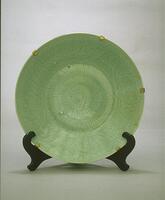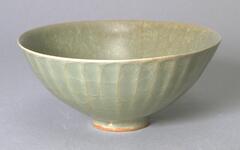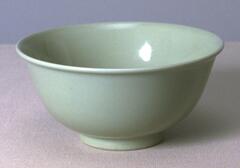Cabinet O: Shelf 3
Celadon Wares in Asia
Although Celadon is the term for a translucent crackle glaze applied to porcelain and stoneware, it has come to mean wares that are specifically greenish blue or gray in color, particularly those from China and Korea. The trademark greenish hues of celadon wares were achieved through the use of clays and glazes that contained small amounts of iron, which turns green in a reduction firing atmosphere. (When there is insufficient oxygen in the air in a kiln, oxygen molecules are pulled from the ceramics themselves; it is this change in chemical composition that changes the color of the ware.) The thickness of the glaze and type of clay determine the color after firing, and getting the “right” effect is extremely difficult. The thin watery glaze runs off high points in the design and pools in impressions, creating dazzling gradations in color, especially in incised and molded designs.
Jade was prized in East Asia, and the ability to imitate its color in porcelain was highly valued. In the Goryeo Period (918-1392) in Korea, a celadon ewer or teacup was more precious than gold or silver. The high estimation of celadon was not limited to Korea, but extended to discerning connoisseurs at the court of the Northern Song dynasty (960–1127) in China. Celadon was quite popular in Japan as well, where it was both imported and manufactured in a native version. Celadon is considered by many to have reached its height during the Goryeo period, and these wares continue to be prized by collectors today.
Created For
K-12 EducatorK-12 Student
Museum Visitor
UMMA Docent
UMMA Staff
University Faculty
University Student
Rate this Resource
AVG: 0 | Ratings: 0
& Author Notes
Creative Commons by-nc-saLast Updated
June 8, 2020 12:52 p.m.Report
Reporting Policy

![<p>This celadon bowl is decorated with mold-impressed designs, which was one of popular type of dishes in 11th and 12th centuries. On its inner walls are lotus scroll designs, and on its inner base is what is presumed to be a lotus flower design. Glaze has been applied all the way down to the rim of the foot, which retains traces of silica supports in three places. The yellow-green glaze is evenly spread on the surface, while the clay is of specially selected high quality, producing a smooth surface.<br />
[<em>Korean Collection, University of Michigan Museum of Art</em> (2014) p.111]</p>
<br />
shallow lobed bowl with molded lotus design on wall, 6 lobes, very small foot, high quality, need cleaning <p>This celadon bowl is decorated with mold-impressed designs, which was one of popular type of dishes in 11th and 12th centuries. On its inner walls are lotus scroll designs, and on its inner base is what is presumed to be a lotus flower design. Glaze has been applied all the way down to the rim of the foot, which retains traces of silica supports in three places. The yellow-green glaze is evenly spread on the surface, while the clay is of specially selected high quality, producing a smooth surface.<br />
[<em>Korean Collection, University of Michigan Museum of Art</em> (2014) p.111]</p>
<br />
shallow lobed bowl with molded lotus design on wall, 6 lobes, very small foot, high quality, need cleaning](/media/W1siZiIsIjIwMjIvMDkvMjQvMmx1M2ptNHMzM19kZWZhdWx0LmpwZyJdLFsicCIsInRodW1iIiwiMjQweDIwMCJdXQ?sha=2ba2ecc35e4531c3)



![<p>This piece represents the archetype of Goryeo celadon made in the 11th century with its shape and designs displaying the in uence of Chinese Yue ware. e glaze was fused well to form a subtle gloss, while the clay body has a ne and dense texture. Around the interior rim is an incised line and also engraved are parrots and clouds below the line. There are four refractory spur marks on the foot.<br />
[<em>Korean Collection, University of Michigan Museum of Art</em> (2014) p.91]</p>
Stoneware teabowl with celadon glaze. A pair of parrots is incised on he inside of the bowl, as well as a line that runs slightly below and parallel to the rim. <p>This piece represents the archetype of Goryeo celadon made in the 11th century with its shape and designs displaying the in uence of Chinese Yue ware. e glaze was fused well to form a subtle gloss, while the clay body has a ne and dense texture. Around the interior rim is an incised line and also engraved are parrots and clouds below the line. There are four refractory spur marks on the foot.<br />
[<em>Korean Collection, University of Michigan Museum of Art</em> (2014) p.91]</p>
Stoneware teabowl with celadon glaze. A pair of parrots is incised on he inside of the bowl, as well as a line that runs slightly below and parallel to the rim.](/media/W1siZiIsIjIwMjIvMDkvMjQvMnQyaGgxdHFoM19kZWZhdWx0LmpwZyJdLFsicCIsInRodW1iIiwiMjQweDIwMCJdXQ?sha=cb35f5778914b8e7)

